
The Politics of Sea Surgery During the GAoP Menu: 1 2 3 4 5 6 7 8 9 Next>>
The Politics of Sea Surgery During the Golden Age of Piracy, Page 6
Macro-Politics: Sea Surgeons And Their Medicines
Now that the medicine supply has been introduced, we must briefly turn from the micro-political to the macro-political realm to understand how the medicines found in their chests were to be supplied to them. This section looks at both how much was expended on medicines from the data we have and who was in charge of supplying and/or inspecting the chests to make sure they were stocked with the right types and amounts of medicines and surgical equipment.

Artist: Nicolas Bernard Lepicie
Examination - Courtyard of the
Customs
House Men (1775)
Charles I had granted money to furnish the chests in 1626 as seen in the chart on the previous page. This money was given to the Company of Barber Surgeons, who then gave it to John Woodall to supply the chests. Although the buck stopped there for a few years, the political wrangling didn't. Even before the 1626 edict, Woodall's medical chests were viewed "by two fellows of the College of Physicians; shortly after this the Society of Apothecaries secured the right to supply ‘physical things’... [with Woodall] providing only for the surgical requirements, in which task he now had the assistance of an apothecary."1
In competitive corporate fashion, the supply of the medicines chests was opened to competitive bidding "with the help of advice from the Apothecaries and the Barber-Surgeons, from certain physicians and from the Company's own serving surgeons". This too was eventually modified, with the advice of "various medical and surgical corporations on all matters falling within their respective fields" being sought.2 So when Woodall was supplying the Navy surgeons' needs, he was a receiving a lot of outside 'help' in doing so.
Like most politically-driven payouts, the money and rules implemented by Charles in 1626 for medical supplies was neither a constant nor consistent practice. By 1635, the money going to the navy had basically been stopped by Parliament. The Navy Office wrote a letter that year stating that they did not understand the 1626 order to be "intended by his Maj[es]ty to give that allowance to Ships Serving on our owne Coast."3 Because there were no foreign wars taking place at this time, this payment all but ceased until the civil war began in England in 1643. At that time, Parliament directed that army surgeons be provided with chests costing £20 which were to be examined by the Society of Apothecaries.4
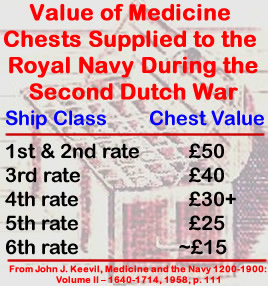
Image Artist: John Nicholls
From The Quack Doctor Outwitted (1710)
Naturally, the cost of the chests increased over time. The next information about the actual costs comes from the fact that the government had not paid the Company of Barber-Surgeons for chests they paid for during the second Dutch War (1664-7). Having not received their payment for what they supplied, the Company sent a report on their expenditures in September of 1668 to the Navy Office explaining that 51 surgeons had been appointed to the fleet during the war and including the estimated value of the chests supplied as seen in the chart at left. Whether they were reimbursed or not is not recorded.5
Under the Commonwealth, the Company of Barber Surgeons' control of the supply of medicines was eroded. A focus on decentralizing the government resulted in the money used for purchasing medicines to be paid directly to the sea surgeons so that they could procure them themselves. Keevil explains that the "direct payments to sea-surgeons by Navy Office not only reduced the [Barber Surgeon] Company's revenue and its authority over these men, but it also undid the efforts at standardization of supplies which had been made in John Woodall's time."6
During the third Dutch War, the Barber Surgeon's Company tried to once again establish a standardized chest, based on a letter sent in 1673. This explained that "at present the Surgeons frequently furnish their chests in obscure places in the remote parts of the town, and thereby sometimes escape their being examined, and they are frequently

Making Up Drugs- A Chemical Laboratory In Paris, From Encyclopedie (1760)
furnished with unwholesome drugs and ill-made medicines". It was therefore advised that "three or four able apothecaries conversant in preparing medicines for the Sea be appointed to supply his Majesty's Ships with medicines". As a result, apothecaries were authorized and delivered the chests to the Company of Barber Surgeons for their inspection, along with a bill for the chests. "The Company, having met the charges and issued a "bill" or "warrant" to a sea-surgeon for forwarding to Navy Office, awaited payment from the free gift and imprest which would be issued against it, but they waited in vain."7
Controlling the money paid and standardization rules for chests wasn't the only bit of macro-political wrangling over the medicine chests. The physicians, ever jealous of the Barber Surgeon's Company's hook into the supply of internal medicines for use at sea considered demanding the right to inspect the medicine chests in 1634, although nothing seems to have come of that.8
The balance of power shifted when the Commonwealth government came to power. They "strongly opposed" monopolies, "and where there was a need for physicians or for physic it disregarded the traditional naval claims of the Barber Surgeons and went to those best able to advise it."9 This was to result in further undermining of the Company's authority. The sea-surgeons' chests were officially being obtained through the Barber Surgeon's Company in the 1660s with the Company repeatedly trying to assert their right to view all the sea surgeon's chests. The government's concern about monopolies scuttled that.10
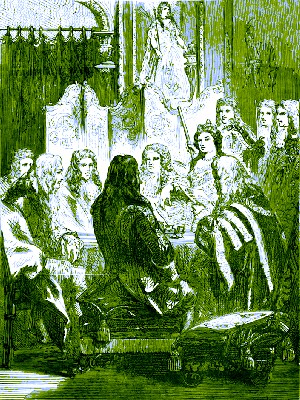
Queen Anne's Privy Council During the Late 17th Century
From Cassell's Illustrated History of England, Vol. 4 (1864)
This also led to a legal challenge to the right of supply. George Soleby, referring to himself as 'his Majesty's sworn apothecary' complained in June 1664 that King Charles II had made him responsible for filling the Navy's medicine chests, but he had only supplied four chests while others had supplied twenty-two of them. "The Privy Council having ordered redress, Soleby was now anxious to fulfill all requirements, and in less than three weeks the wardens were able to certify the correctness of the quality and quantity of the medical and surgical stores he had supplied; they considered that the price was reasonable."11 However, in an effort to avoid creating a new monopoly, the Privy Council was cautious not to give Soleby sole right to the supply naval medical chests.12
When the third Dutch War began in 1672, the Company of Barber Surgeons again turned their attention to viewing the surgeon's medicine and instrument chests. This task was delegated to James Pearse, warden of the Company and Surgeon-General to the Duke of York's flagship.13 His dual position with the company and the navy gave him a great deal of power during this war. Once the war started, the surgeons petitioned to have half their imprest money and the free gift given them, citing "heavy demands made on them by the number of sick and wounded in the fleet" during the 1672 Battle of Solebay, which was granted to them.14 Presumably, they purchased their chests wherever they wanted and had them examined by the Company.
By 1690 at the beginning of William's War, this duty had been usurped by the Worshipful Society of Apothecaries, who were having their own political troubles( as they battled to keep this right away from the College of Physicians.15 The Company of Barber Surgeons was still officially in charge of certifying the surgeon's chests, even though this right was challenged by the Royal Greenwich Hospital in 1715.16 This occurred when the Admiralty told the Company that it was transferring the right to inspect the chests to Dr. William Oliver and Mr. Isaac Rider of Greenwich Hospital. The Company protested, citing Charles I's charter which gave them this right. However "on June 4, 1715, their Clerk replied stating the Barber-Surgeons readiness to share the duties which they alone had performed, and to hold courts for the purpose [of examining the chests] on the first Friday in each month. Henceforward this became a regular procedure"17. In this way, they still 'officially' maintained their right to view the chests.
1,2 John J. Keevil, Medicine and the Navy 1200-1900: Volume I – 1200-1649, 1957, p. 204; 3 Keevil, Volume 1, p. 200; 4 Keevil, Volume 1, p. 201; 5 John J. Keevil, Medicine and the Navy 1200-1900: Volume II – 1640-1714, 1958, p. 111; 6 Keevil, Volume II, p. 111-2; 7 Keevil, Volume II, p. 151; 8 Keevil, Volume II, p. 32; 9 Keevil, Volume II, p. 28; 10 Keevil, Volume II, p. 150-1; 11 Keevil, Volume II, p. 102; 12 Keevil, Volume II, p. 151; 13 Keevil, Volume II, p. 113; 14 Keevil, Volume II, p. 126-7; 15 Harold J Cook, "Practical Medicine and the British Armed Forces After the 'Glorious Revolution," Medical History, p. 16; 16 Sidney Young, The Annals of the Barber-surgeons of London, p. 350-1; 17 Keevil, Volume II, p. 255-6
Macro-Politics: The Navy on Medical Supply
Although it may seem as if the different medical companies and the King primarily decided how and with what the sea and army medical chests were to be supplied and checked, the navy also had a say in the matter.
When Queen Anne assumed the throne, her husband Prince George of Denmark became Lord High Admiral. 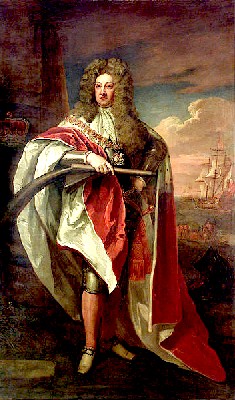
Artist: Godfrey Kneller
Prince George as Lord High Admiral (c. 1704)
He took a great interest in naval matters including the supply and quality of the drugs issued to the Navy. He wrote in February of 1702,
Whereas it hath been represented unto me, that great quantitys of the Medicines wherewith the Chests of the Chirurgeons lately sent to the Fleet were furnished, are so very bad that they are not fitt for use and whereas a thing of this consequence to Her Majesty's service ought in the strictest manner to be enquired into in regard to the Lives of such Seamen who shall happen to be Sick or Wounded, doe in a great measure depend upon the holesomeness of the Medicines sent to the Fleet, for which reason I have ordered the Surgeon's Chests lately sent from the [Surgeon's] Hall to Portsmouth and Chatham to be forthwith Brought up to Town and lodged in the Hall belonging to the Apothecary's Company and directed such of the Commissioners for Sick and Wounded as are Physitians in conjunction with such Surgeons and Apothecarys as they shall judge proper, carefully to survey the aforesaid medicines there, and report to me how they shall find the same. ...I do therefore hereby desire and direct you to take particular care that no medicines be sent on board any of Her Majesty's Shipps for the Future, till such times as they shall be surveyed as aforesaid and certified to be good and holesome... Nor are you to pay to any Surgeon whatever the Allowance Free Gift till such time as they produce unto you Certificates under the hands of the Surveyors that their Chests are supplyed with medicines as they ought to be.1
The College of Surgeons, who had been involved in specifying and supplying drugs for the army and navy as recently as 1691, "established a dispensary in London, [and once] again tried to contract with the Crown for supplying the medicines to the army and navy."2 The apothecaries petitioned the Crown to maintain their right to inspect the armed forces medicine chests. In July of 1702, Prince George wrote another letter ordering 'the Surgeons of Her
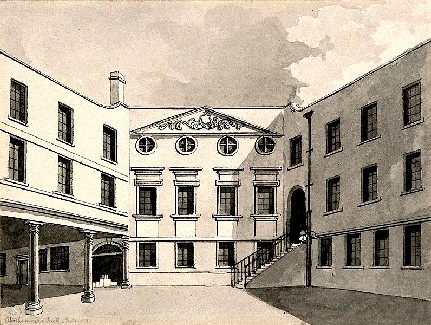
Apothecaries Hall Courtyard, Blackfriar's Lane, London, From the Wellcome Collection
Majesty's Shipps to furnish and provide their Chests, at the common Hall of the Company of Apothecary's, and not in any other place, the said Company having assured me they will furnish both good and cheape."3
Part of the problem with having the College of Physicians involved in the supply of medicines to the military was that the two groups had markedly different intents. The philosophy of the College of Physicians was that each individual patient was unique with his illness being particular to him which required a specific and singular treatment. Such treatments required individual consultations with the cure often taking weeks and even months to complete. This was directly at odds with the philosophy of the military establishment who wanted to be able to treat the problem rather than the individual, and to treat that as quickly as possible. Historian Harold Cook explains, "The military wanted quick and efficacious cures for specific diseases that would be good for any soldier or sailor in any circumstances, while the learned physicians wished to maintain the importance of learned physic, with its emphasis on the individual."4
In addition, the Navy needed remedies that the sea surgeons could quickly choose and administer, particularly during chaotic medical crises such as mass illness or battle conditions. The physicians preferred to determine which medicines were appropriate for each case, basing their prescriptions on the humors of the patient, the type of medical problem the patient had, the climate at that particular location and similar factors.
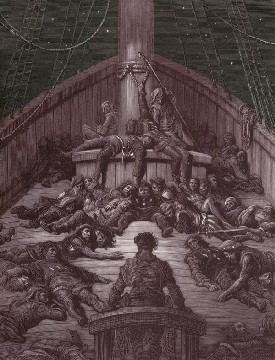
Artist: Gustav Dore
Shipboard Illness, From "...and yet I could not die",
Illustration for
Rime of the Ancient Mariner (1876)
This resulted in an open quarrel between the College of Physicians and the Admiralty in 1695.
The Admiralty met with the College to get advice on more efficacious drugs following a disastrous voyage to the West Indies in 1693. In this voyage, Sir Francis Wheeler had led two ships and six frigates to attack Martinique but the attack failed because his men were so "weakened by diseases... [that] in his return voyage his crews were so reduced by deaths from scurvy and fever that there were hardly hands enough to bring the ships to anchor."5
The physicians felt the problem was spoiled medicines and recommended "that the Admiralty support their efforts to guarantee the quality by firmly governing the apothecaries."6 The Physicians were interested in gathering control of the process as much as (if not more than) they were in solving it. The Navy wasn't interested in the politics of the medical branches however. They requested an invoice of medicines for two hundred men for a six month voyage. The College insisted that the medicines used in 1693 had been faulty and they should be put in charge of inspecting them in the future, but the Admiralty said "they could supervise the inspection of the quality of the drugs themselves."7
As the meeting continued, it became plain to the officers of the College that Their Lordships [the Admiralty] wanted specific [patent/empirical] medicines, the kind of medicines the physicians associated with quackery: good for a specific disease in all cases whatsoever, no matter what the age, temperament, or circumstances of the patient. For their part, the learned physicians believed that no disease was precisely the same in every patient, and that consequently patients had to be treated individually, with the drugs varied according to the gender, age, and circumstances of the patient and the precise moment at which the ever-changing manifestations of the illness was found.8
Finally, Sir Robert Rich "said, ‘an Envoice for 200 men was an Envoice, and a fever was a fever all the world over’. The physicians’ reply that different places and climates had different diseases, brought the interview to an end. Their Lordships were getting nowhere, and dismissed the physicians."9
The navy recognized that there were a lot of advantages to them in using patent (empiric) medicines. Cook notes that "the more regularized and standardized each step of diagnosis and treatment became, the easier it would be to treat soldiers and sailors, to train new practitioners quickly and well, and to find new medical specifics for particular diseases or new operations for patching up wounds."10
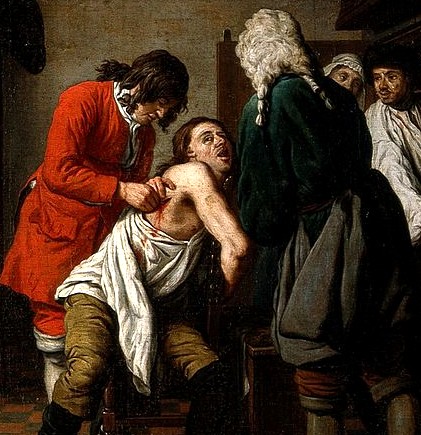
Artist: Johan Joseph Horemans
Surgeon Attending to a Wound in a Man's Side (18th c.) Wellcome Collection
It would also likely result in there being fewer medicines in the surgeon's medicine chest, making it easier for him or his mate to locate the medicine required for a particular problem when treating men during battle or when illnesses ravaged a ship.
As discussed, It must also be remembered that many of the sea surgeons were young and inexperienced when they were brought into naval service. In addition, if the surgeon died at sea, his even less experienced mate or assistant would be promoted to head surgeon because no one else was even remotely qualified for the job. Many of these men were also pressed into service and had little need or interest in learning to administer internal remedies as explained on the previous page. The simpler the administration of medicines was, the more likely such inexperienced and unmotivated men would be to use the recommended remedy.
Sea surgeon John Woodall, citing French surgeon Jacques Guillemeau, no doubt had such ideas in mind when he said,
The Emperike Medicaments which the methodicall Physitians so disdaine and esteeme of little worth, are those which wee through our experience, and through the diuturnall [long-lasting] use of them, have found to be most excellent, which being used with Judgement, are not to be disdained, seeing the Gallen himselfe testitifeth, that the Physition must be established on two foundations, to wit, reason and experience11
As a result, the College of Physicians remained out of favor with the Navy administration throughout most of the golden age of piracy. In their defense, many of the empiric medicines that were tried by the Navy failed to work quite as well as their creators advertised and health problems continued to have damaging effects on long voyages.
1 Sir Cecil Wakely, Surgeons and the Navy, transcript of Thomas Vicary Lecture delivered at the Royal College of Surgeons in England, 11/14/1957, p. 275-6; 2 Harold J. Cook, "Practical Medicine and the British Armed Forces After the ‘Glorious Revolution," Medical History, 1990, 34, p. 12; 3 Wakely, p. 276; 4 Cook, p.14; 5 William A. Guy, Public Health, A Popular Introduction to Sanitary Science, 1870, p.150-1; 6,7,8 Cook, p.13; 9 Cook, p.14; 10 Cook, p.2; 11 John Woodall, the surgions mate, 1617, p. 207
Micro-Politics: A Sea Surgeon on Medical Supply
John Atkins provides some insight into the individual Navy sea surgeon's thoughts on medicine supply from the golden age of piracy. Atkins was a Navy surgeon whose career took place entirely during the golden age of piracy. He entered the British Navy as a junior surgeon's mate of the Charles Galley in 1701.
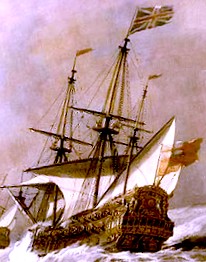
Artist: Willem van de Velde the Younger
British 4th Rate Ship of the Line (1678)
Following his treatment of sailor's wounds during battle at sea off Malaga in 1703, "his captain found him diligent, respectful, sober, and worthy of better things"1. Atkins moved up to the role of surgeon's first mate in the Somerset in 1704.2 Atkins earned his diploma from the Barber Surgeons Company in 1715, but wasn't commissioned as a ship's surgeon until 1718.3 He served until 1723 when he was unable to get another berth as surgeon and so he entered private practise in Plaistow, Essex.4
Atkins was also directly involved with the pirates. In 1721 he sailed with the Swallow (a fourth rate ship) and her tender, the Essex (a third rate), which were sent to Africa to combat piracy. Under the command of Captain Chaloner Ogle, these ships captured 270 of Bartholomew Roberts' pirates at Cape Lopez in early 1722. Atkins was made registrar at the pirate's trials and it is from his notes that we have the trial account.5 While this secured his place in the history of piracy, Atkins said of this task, "for twenty-six hard days' work he only received as many pounds."6
Atkins published a book on sea surgery called The Navy-Surgeon or, a Practical System of Surgery in 1734 with a second edition being released in 1737 and a third in 1742. In the 1734 edition, Atkins observed that "for the common and general Parts of Surgery, (recent Cases,) I know no better School to improve in, than the NAVY, especially in Time of War, Accidents
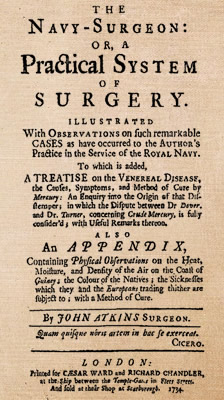
John Atkins' The Navy Surgeon (1734)
are frequent, and the Industrious illustrate Practice by their Cures."7 He also expresses his views on the nature medicine in sea surgery, noting that "Physick, as it relates to Surgery, being, in my Opinion, neither so very ample or mysterious". He goes on to suggest "that separating Medicines that have a sensible Operation, Opiates, Restrictives, and Cardiacks, we seem to have the Whole for Use; and, perhaps, if we add two or three Specificks, and a thorough Knowledge in the Non-Naturals, we have all of Physick that is useful in other Cases."8 This shows that the debate over whether sea surgeons should be allowed to practice the physician's tasks was still taking place throughout the golden age of piracy.
However, it is not Atkins' thoughts on the over-complexity of the role of the physicians and their internal medicines that are of interest; it is his views on the supply of those medicines. These begin with a very brief overview of how the medicines were provided.
The Navy is supplied with Medicines under the Direction of the Apothecaries Company and a Physician; who put up not what the Surgeon wants, but what they say he wants; the Invoice being fixed, in which the most commendable Part is the Reduction of Number, (not one twentieth part perhaps of the Catalogue in Dispensatories;) which I think could not be done, without Uncharitableness... unless this Multiplicity in Practice were tacitly allowed a just Complaint, and the other nineteen [medicines were] granted to be useless, or, which is much the same thing, like Marygolds in Porridge.9
From the outset, we can see that Atkins was no great fan of the medicine supply, putting a dig in his introduction at both the College of Physicians for including too many medicines in their Dispensatory and at the Physician and Apothecaries who made up the chest for not giving the surgeons enough types of medicines. This seems curiously at odds with his previous comments, although many compounded medicines did indeed include extraneous ingredients which served little better use than 'marigolds in porridge'.
Atkins then goes back to the idea that the number of medicines included in the sea surgeon's chests was excessive, with several eminently practical reasons for saying so:

Frontispiece From The Expert Doctor's Dispensary,
by Pierre Morel, Wellcome Images (1657)
“I think the Invoices [for the medicines] might be still usefully diminished, or at least a better Change made in them: Electuaries, Conserves, Syrups, Herbs, Roots, Flowers, and the like, quickly decay in warm Climates, and as most of them can be substituted, or the Country [to which the ship was sailing] (unless unblessed) has something equivalent [to that supplied in the chest], all large Quantities [of Medicines] are Impositions; other Medicines, again, from our not knowing what they are good for, or their being of little Esteem must either be given, like many eminent Prescriptions, without an Meaning, or kept covered till the Chest returns [to its home port], and then [the unused medicines are] thrown away; a convincing Evidence I think of the Mistake in reducing every Man’s Understanding to one Size in Practice; and that the Surgeon ought to have a considerable Share in the Choice and Quantity to be taken on board.10
Atkins comment that the unused medicines were thrown away was probably because they had deteriorated during the voyage. Keep in mind that the majority of medicines found in the surgeon's chest were made from simple, natural ingredients. This is also why many of them would "quickly decay in warm Climates".
Atkins' suggestion to simplify the supply and to consult the surgeon when deciding what to bring on the voyage is very enticing, particularly from the point of view of the man who received the chest. However, each surgeon who writes about the types of medicines to be used in a military capacity seems to have their own ideas about which were preferable for various health problems. If each surgeon were consulted about the medicines they wanted, there would be no uniformity between different sea surgeons' medicine chests. This was the beauty of John Woodall's system. He recommended the medicines, specified their location in the chest so that they were easy to find, and explained what each medicine was to be used for in his book that was to be included with the chest.

